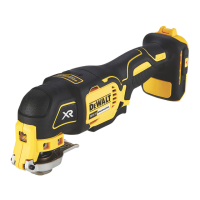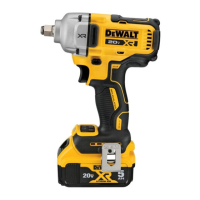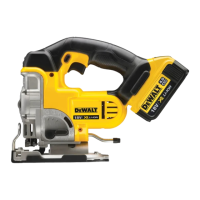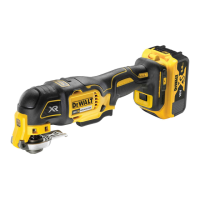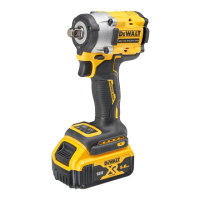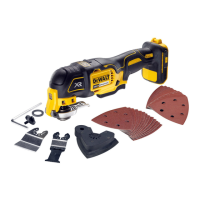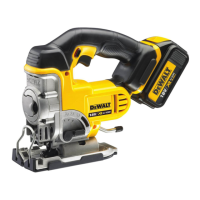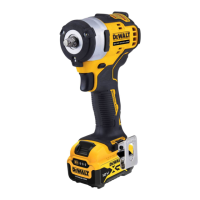55
ENGLISH
2. Place the sanding disc
21
on the backing pad
20
.
3. While depressing spindle lock button
4
, thread the sanding
clamp nut
22
on spindle, piloting the raised hub on the
clamp nut into the centre of san ding disc and backingpad.
4. Tighten the clamp nut by hand. Then depress the spindle
lock button while turning the sanding disc until the sanding
disc and clamp nut aresnug.
5. To remove the wheel, grasp and turn the backing pad and
sanding pad while depressing the spindle lockbutton.
Mounting and Removing Hubbed Wheels (Fig.A)
Hubbed wheels install directly on the spindle. Thread of
accessory must match thread ofspindle.
1. Thread the wheel on the spindle
5
byhand.
2. Depress the spindle lock button
4
and use a wrench to
tighten the hub of thewheel.
3. Reverse the above procedure to remove thewheel.
NOTICE: Failure to properly seat the wheel before turning
the tool on may result in damage to the tool or thewheel.
Mounting Wire Cup Brushes and WireWheels (Fig.A)
WARNING: Failure to properly seat the brush/wheel could
result in serious injury (or damage to the tool orwheel).
CAUTION: To reduce the risk of personal injury,
wear work gloves when handling wire brushes and
wheels. They can becomesharp.
C
AUTION: To reduce the risk of damage to the tool,
wheel or brush must not touch guard when mounted
or while in use. When using a Type A (cut-off), or Type B
(grinding) wheel guard with a wheel-type wire brush with a
thickness greater than the maximum thickness as specified in
the Accessory and Guard Applications Chart , the wires
may catch on the guard leading to breaking of thewires.
Wire cup brushes or wire wheels install directly on the threaded
spindle without the use of locking flange. Use only wire brushes
or wheels provided with a M14 threaded hub. These accessories
are available at extra cost from your local DeWALT
dealer or
authorised DeWALT
servicecentre.
1. Place the tool on a table, guardup.
2. Thread the wheel on the spindle
5
byhand.
3. Depress spindle lock button
4
and use a wrench on the
hub of the wire wheel or brush to tighten thewheel.
4. To remove the wheel, reverse the aboveprocedure.
NOTICE: To reduce the risk of damage to the tool, properly
seat the wheel hub before turning the toolon.
Prior to Operation
• Install the guard and appropriate disc or wheel. Do not use
excessively worn discs orwheels.
• Be sure the threaded locking flange are mounted correctly.
Follow the instructions given in the Accessory and Guard
ApplicationChart.
• Make sure the disc or wheel rotates in the direction of the
arrows on the accessory and thetool.
• Do not use a damaged accessory. Before each use inspect
the accessory such as abrasive wheels for chips and cracks,
operatorprotection.
The guard release lever should snap into one of the
alignment holes
15
on the guard collar. This ensures that
the guard issecure.
5. To remove the guard, follow steps 1–3 of these instructions
inreverse.
Flanges and Wheels
WARNING: To reduce the risk of serious personal
injury, turn unit off and remove the battery pack
before making any adjustments or removing/
installing attachments or accessories. An accidental
can causeinjury.
Mounting Non-Hubbed Wheels (Fig.G)
WARNING: Failure to properly seat the flanges and/or
wheel could result in serious injury (or damage to the tool
orwheel).
CAUTION: Included flanges must be used with depressed
centre Type 27/42 grinding wheels and Type1/41 cutting
wheels. Refer to the Accessory and Guard Applications
Chart for moreinformation.
WARNING: A closed, two-sided cutting wheel guard is
required when using abrasive cutting wheels or diamond
coated cutting wheels, referred to as a Type A cut-off
wheelguard.
WARNING: Use of a damaged flange or guard or fail-
ure to use proper flange and guard can re sult in injury
due to wheel breakage and wheel contact. Refer to
the Accessory and Guard Applications Chart for
moreinformation.
1. Place the tool on a table, guardup.
2. Place wheel
19
against the backing flange
7
, centreing the
wheel on the raised centre (pilot) of the backingflange.
3. While depressing the spindle lock button and with the
hex depressions facing away from the wheel, thread the
threaded locking flange
8
on spindle so that the lugs
engage the two slots in thespindle.
4. While depressing the spindle lock button, tighten the
threaded locking flange
8
using a hexwrench.
5. To remove the wheel, depress the spindle lock button and
loosen the threaded lockingflange.
Mounting Sanding Backing Pads (Fig.A, H)
NOTE: Use of a guard with sanding discs that use backing pads,
often called fiber resin discs, is not required. Since a guard is
not required for these accessories, the guard may or may not fit
correctly ifused.
WARNING:
Failure to properly seat the clamp nut and/
or pad could result in serious injury (or damage to the
tool orwheel).
WARNING: Proper guard must be reinstalled for grinding
wheel, cutting wheel, sanding flap disc, wire brush or
wire wheel applications after sanding applications
arecomplete.
1. Place or appropriately thread backing pad
20
on thespindle.
